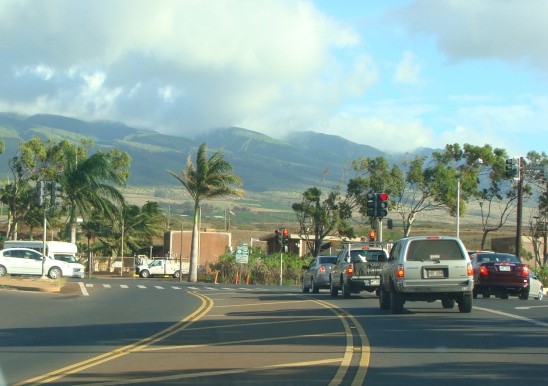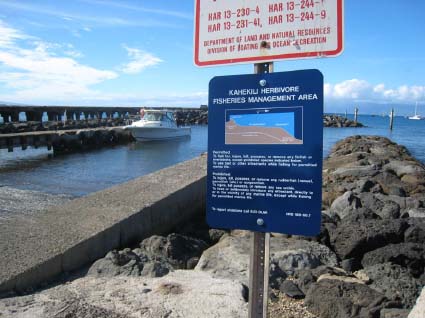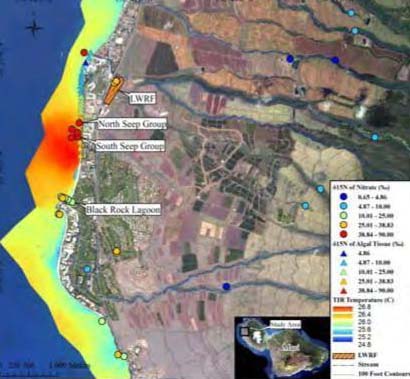Settlement Reached Lawsuit over Maui Clean Water Act Violations

Lower Honoapiilani Highway near the Lahaina Wastewater Reclamation Facility. File photo by Wendy Osher.
By Wendy Osher
Maui County could end up paying $2.5 million for projects to divert and reuse wastewater from Lahiana injection wells, under a settlement reached in a federal lawsuit over Clean Water Act violations.
The lawsuit was filed by the environmental law firm Earthjustice on behalf of four community groups including the Hawaiʻi Wildlife Fund, Surfrider Foundation, Sierra Club-Maui Group, and West Maui Preservation Association

Signs are posted along areas protected in the Kahekili Herbivore Management Area. File photo courtesy Division of Aquatic Resources.
Under the agreement the county is required to come up with safer ways to dispose of wastewater at its Lahaina Wastewater Reclamation Facility.
According to Earthjustice, the county will spend funds on projects designed to divert treated wastewater from the Lahaina injection wells, and reuse that water to meet existing water demands in West Maui.
“The County will also pay a $100,000 penalty to the federal treasury and, to bring its injection wells into legal compliance, must obtain and comply with a Clean Water Act permit,” said Earthjustice representatives in a press release announcement today.

ES-6: Infrared SST showing values of terestrial and marine waters, and the intertidal macroalgae. Image courtesy Tracer Study report conducted by UH for state DOH, and US EPA. Access to report provided by Earthjustice.
County officials released a statement in response to the settlement today saying the agreement settles the penalty phase of a lawsuit, but that they plan to appeal lower court rulings relating to the case.
“If successful, the County will continue operating the facility under the state and federal Safe Drinking Water Act permits. If the appeal is not successful, the County will need also to obtain an NPDES permit for continued operations and has agreed to implement a $2.5 million water-reuse project in West Maui,” county officials said.
In January, a federal court ruled that illegal discharge of wastewater had occurred in violation of the federal Clean Water Act, affecting offshore waters at the popular Kahekili Beach Park in West Maui.
Earthjustice had filed a lawsuit on behalf of several island groups in April 2012, claiming that wastewater containing bacteria and other pathogens from injection wells was making its way into the ocean. The suit further claimed that the discharge was “contributing to algal growth, and harming the sensitive coral reef ecosystem.”
According to Earthjustice, the county has injected “millions of gallons” of wastewater into underground wells “for decades, on a daily basis.”
In 2013, Earthjustice states that the groups’ concerns were “vindicated” when a University of Hawai‘i study put dye into the injection wells to trace the wastewater’s path to the ocean and, “In a matter of months, the researchers detected the dye flowing out of seeps in the Kahekili reef.”
“The Clean Water Act requires that polluters pay civil penalties for their Clean Water Act violations,” said Earthjustice attorney David Henkin in today’s announcement. “Today’s settlement ensures the lion’s share of the penalty for the County’s years of violations will be invested to solve problems in West Maui, protecting fragile coral reefs and helping to address chronic water shortages,” said Henkin.
Sierra Club-Maui Group representative, Lucienne de Naie also released a statement saying, “This settlement is a major victory in getting the County to stop using the reef off of Kahekili Beach as its wastewater dumping ground. It requires the County to invest in sensible alternatives to injection, meeting existing demand for precious water in West Maui by constructing infrastructure to get treated wastewater to golf courses, resorts, and others.”
Lauren Blickley of Surfrider Foundation also commented saying, “With the projects called for under the settlement, beachgoers in West Maui can look forward to improved water quality and coral reef health at one of their favorite snorkeling and swimming spots.”
In a statement released by the County of Maui, officials said the county applied with the DOH for an NPDES permit two years ago, and a draft NPDES permit in 2015. According to county officials, the DOH has yet to issue or comment on the permit application, and no action has been taken on the draft document.
Maui Mayor Alan Arakawa said he expects that there will be “significant interest in the appeal of the lower court’s decisions from other potentially affected municipalities and states across the nation.” He called the situation a “national battle,” that he said, “is being fought at the expense of Maui’s taxpayers.”
Lance D. Collins, spokesperson for West Maui Preservation Association released a statement saying, “It’s disappointing that the County chose to fight tooth and nail, wasting taxpayer money on expensive mainland lawyers rather than trying to protect the reefs at Kahekili Beach. We hope the settlement is a turn in the right direction. Reusing wastewater is good for the reef and good for West Maui’s pressing water needs.”
Hannah Bernard of the Hawai‘i Wildlife Fund called impacts to a “once pristine coral reef ecosystem,” tragic saying, “The County should embrace its role as steward of Maui’s natural resources and treat this settlement as a starting point to do all it can to save what’s left of this fragile reef, including eventually shutting down the wells for good.”
According to Mayor Arakawa, many other states discharge recycled water into groundwater for a variety of “accepted and important purposes,” including aquifer recharge and as a salt-water intrusion barrier.
County representatives explain that this is when the “fresh water forms a barrier so that the salt water does not intrude into a fresh water aquifer.”
According to a county issued press release, the District Court developed a new “conduit” theory of Clean Water Act liability, that states the “groundwater acts as a conduit for the recycled water to reach the ocean a half-mile away.” County officials say, “the Court’s theory acts to extend the reach of the Clean Water Act to groundwater, which has historically been regulated under the Safe Drinking Water Act.”
County officials note that the EPA estimates there are anywhere between 400,000 and 650,000 Class V UIC wells – the type of UIC well at issue in the County’s case. “In Hawaiʻi alone, the EPA reports that there are more than 5,600 such wells,” the county press release said.
Mayor Arakawa said the court’s ruling, “leaves municipalities in regulatory limbo.” He said the rulings, “have far-reaching implications,” which is why he said, “the County must appeal this decision.”










